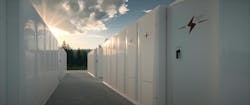Sacramento Municipal Utility Signs PPA for 640-MWh Dry Creek Battery Project
Northern California utility Sacramento Municipal Utility District (SMUD) is committing to a long-term power purchase agreement for the output of a future 160-MW/640-MWh battery energy storage system (BESS) project within its territory.
The Dry Creek Energy Storage project is going to be built in Sacramento County and connect into the nearby Rancho Seco Solar II substation, according to reports. Construction on the Dry Creek battery complex, which is being developed D.E. Shaw Renewable Investments (DESRI), is expected to begin next year.
“This project will play a critical role in helping SMUD to maintain and enhance grid reliability, optimize performance of their renewable energy assets and contribute to their decarbonization goals,” said DESRI Chief Development Officer, Hy Martin, in a statement.
SMUD and DESRI have worked together on the project together for many years. The Dry Creek BESS is being sited on the grounds near where the retired Rancho Seco Nuclear Power Generating Station was located. Rancho Seco Nuclear Station was commissioned in 1975 and retired 14 years later due to low performance and economic viability issues.
SMUD will utilize the battery energy storage capacity to help smooth grid reliability during times of peak demand. The energy storage system will be charged using renewable energy and other clean sources available on SMUD’s grid to support the integration of sustainable power and enhance grid reliability.
"This battery storage project represents another significant milestone in SMUD's Zero Carbon Plan as we work toward carbon-free electricity by 2030," said SMUD Chief Zero Carbon Officer, Lora Anguay. "By enhancing our existing renewable infrastructure at Rancho Seco with battery technology, we're building a more flexible and reliable grid while enabling a more efficient integration of renewable energy."
Strategically timed deployment of battery storage capacity is considered useful in helping balance the intermittencies of renewable energy generation. The most recent U.S. Energy Storage Monitor report by the non-profit American Clean Power Association and research partner Wood Mackenzie indicated that the nation’s grid utilities added more than 12 GW of installed battery capacity last year.
